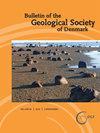Clay mineral assemblages as a tool in source-to-sink studies: an example from the Lower Cretaceous of the North Sea Basin
IF 1
4区 地球科学
Q2 Earth and Planetary Sciences
引用次数: 0
Abstract
The alternating marlstone and chalk of the Lower Cretaceous succession in the Danish Central Graben (DCG) are important for the understanding of the evolution of the larger North Sea Basin. This study focusses on the clay mineral assemblages of the upper Hauterivian – lower Aptian in the DCG and Danish Basin (DB) and their implications. Clay mineral assemblages are predominantly used to assess palaeoclimate. In this study, however, they were additionally used in a source-to-sink context. Kaolinite was found to form a dominant component of the clay mineral assemblage in the sampled wells of the DCG and in the DB, suggesting that a feldspar- or kaolinite-rich source was present and actively eroded in the region during the Early Cretaceous. Moreover, a decreasing gradient west to east of average kaolinite content is observed in the three studied wells for the early Hauterivian to late Barremian (BC9-BC17), with the highest content observed in the North Jens-1 well (av. 74%), followed by the Boje-2C well (av. 49%) and lastly in the Vinding-1 well (av. 39%). Due to the relatively rapid settling of kaolinite in marine environments compared to other clay minerals, this gradient suggests that the main clay mineral source was located in the south-western part of the DCG. Isochore maps, a new palaeogeographic map of the DCG and the western part of the German sector of the North Sea illustrates where Lower Cretaceous rocks are absent in this region, due to either erosion or non-deposition. Potential subaerially exposed highs included the distant Baltic Shield to the north, the Ringkøbing–Fyn High to the east and the Heno Plateau within the DCG, with the latter being located closest to the North Jens-1 well and containing feldspar-rich sandstones of the Heno Formation (upper Kimmeridgian – lowermost Volgian/Tithonian). During the Early Cretaceous, part of the Heno Formation was potentially subaerially exposed or subject to wave reworking/erosion in parts of the Danish and German sectors. The sandstones could weather into kaolinite and this structural high is therefore suggested to have been the main source area for this part of the DCG, with minor sediment influxes from the Ringkøbing–Fyn High and Baltic Shield. In addition, the overall decrease in kaolinite in the DCG from the late Hauterivian to the late Barremian indicates a climatic change towards drier conditions, with some minor, slightly more humid periods.黏土矿物组合作为源-汇研究的工具:以北海盆地下白垩统为例
丹麦中央地堑(DCG)下白垩统泥灰岩与白垩岩交替演替,对认识北海盆地演化具有重要意义。本文研究了丹麦盆地和丹麦盆地上奥特里维统-下阿普梯统的粘土矿物组合及其意义。粘土矿物组合主要用于评估古气候。然而,在本研究中,它们被额外地用于源到汇的上下文中。在DCG和DB取样井中发现高岭石是粘土矿物组合的主要组成部分,表明该地区早白垩世存在一种富含长石或高岭石的来源,并受到积极侵蚀。此外,研究的3口井中,早第三纪至晚巴雷米统(BC9-BC17)高岭石平均含量呈自西向东递减的梯度,其中北延斯-1井含量最高(74%),其次是Boje-2C井(49%),最后是温丁-1井(39%)。与其他黏土矿物相比,高岭石在海洋环境中的沉降速度相对较快,这一梯度表明主要黏土矿物源位于DCG的西南部。等差线图是一幅新的古地理地图,显示了DCG和北海德国部分西部的下白垩纪岩石在该地区的缺失,原因要么是侵蚀,要么是未沉积。潜在的水下暴露高地包括北部遥远的波罗的海盾,东部的ringk ø bingn - fyn高地和DCG内的Heno高原,后者位于最靠近北Jens-1井的位置,含有Heno组(上kimmeridian -下Volgian/Tithonian)富含长石的砂岩。早白垩纪时期,在丹麦和德国部分地区,部分Heno组可能处于水下暴露或受到波浪改造/侵蚀。砂岩可以风化成高岭石,因此该构造高地是DCG这部分的主要源区,还有少量来自Ringkøbing-Fyn高地和波罗的海地盾的沉积物流入。此外,从豪特里维亚晚期到巴雷米亚晚期,DCG高岭石的总体减少表明气候向干燥条件转变,有一些较小的,稍微潮湿的时期。
本文章由计算机程序翻译,如有差异,请以英文原文为准。
求助全文
约1分钟内获得全文
求助全文
来源期刊

Bulletin of the Geological Society of Denmark
GEOSCIENCES, MULTIDISCIPLINARY-
CiteScore
2.80
自引率
16.70%
发文量
28
审稿时长
>12 weeks
期刊介绍:
The Bulletin publishes contributions of international interest in all fields of geological sciences on results of new work on material from Denmark, the Faroes and Greenland. Contributions based on other material may also be submitted to the Bulletin if the subject is of relevance for the geology of the area of primary interest.
 求助内容:
求助内容: 应助结果提醒方式:
应助结果提醒方式:


